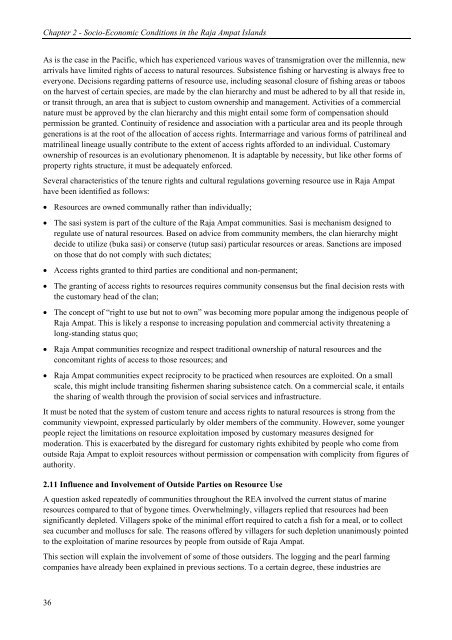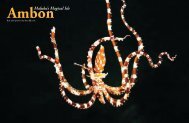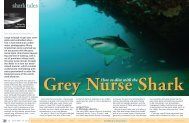Rapid Ecological Assessment - Indo-Pacific Images
Rapid Ecological Assessment - Indo-Pacific Images
Rapid Ecological Assessment - Indo-Pacific Images
- No tags were found...
You also want an ePaper? Increase the reach of your titles
YUMPU automatically turns print PDFs into web optimized ePapers that Google loves.
Chapter 2 - Socio-Economic Conditions in the Raja Ampat Islands<br />
As is the case in the <strong>Pacific</strong>, which has experienced various waves of transmigration over the millennia, new<br />
arrivals have limited rights of access to natural resources. Subsistence fishing or harvesting is always free to<br />
everyone. Decisions regarding patterns of resource use, including seasonal closure of fishing areas or taboos<br />
on the harvest of certain species, are made by the clan hierarchy and must be adhered to by all that reside in,<br />
or transit through, an area that is subject to custom ownership and management. Activities of a commercial<br />
nature must be approved by the clan hierarchy and this might entail some form of compensation should<br />
permission be granted. Continuity of residence and association with a particular area and its people through<br />
generations is at the root of the allocation of access rights. Intermarriage and various forms of patrilineal and<br />
matrilineal lineage usually contribute to the extent of access rights afforded to an individual. Customary<br />
ownership of resources is an evolutionary phenomenon. It is adaptable by necessity, but like other forms of<br />
property rights structure, it must be adequately enforced.<br />
Several characteristics of the tenure rights and cultural regulations governing resource use in Raja Ampat<br />
have been identified as follows:<br />
• Resources are owned communally rather than individually;<br />
• The sasi system is part of the culture of the Raja Ampat communities. Sasi is mechanism designed to<br />
regulate use of natural resources. Based on advice from community members, the clan hierarchy might<br />
decide to utilize (buka sasi) or conserve (tutup sasi) particular resources or areas. Sanctions are imposed<br />
on those that do not comply with such dictates;<br />
• Access rights granted to third parties are conditional and non-permanent;<br />
• The granting of access rights to resources requires community consensus but the final decision rests with<br />
the customary head of the clan;<br />
• The concept of “right to use but not to own” was becoming more popular among the indigenous people of<br />
Raja Ampat. This is likely a response to increasing population and commercial activity threatening a<br />
long-standing status quo;<br />
• Raja Ampat communities recognize and respect traditional ownership of natural resources and the<br />
concomitant rights of access to those resources; and<br />
• Raja Ampat communities expect reciprocity to be practiced when resources are exploited. On a small<br />
scale, this might include transiting fishermen sharing subsistence catch. On a commercial scale, it entails<br />
the sharing of wealth through the provision of social services and infrastructure.<br />
It must be noted that the system of custom tenure and access rights to natural resources is strong from the<br />
community viewpoint, expressed particularly by older members of the community. However, some younger<br />
people reject the limitations on resource exploitation imposed by customary measures designed for<br />
moderation. This is exacerbated by the disregard for customary rights exhibited by people who come from<br />
outside Raja Ampat to exploit resources without permission or compensation with complicity from figures of<br />
authority.<br />
2.11 Influence and Involvement of Outside Parties on Resource Use<br />
A question asked repeatedly of communities throughout the REA involved the current status of marine<br />
resources compared to that of bygone times. Overwhelmingly, villagers replied that resources had been<br />
significantly depleted. Villagers spoke of the minimal effort required to catch a fish for a meal, or to collect<br />
sea cucumber and molluscs for sale. The reasons offered by villagers for such depletion unanimously pointed<br />
to the exploitation of marine resources by people from outside of Raja Ampat.<br />
This section will explain the involvement of some of those outsiders. The logging and the pearl farming<br />
companies have already been explained in previous sections. To a certain degree, these industries are<br />
36





